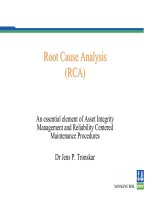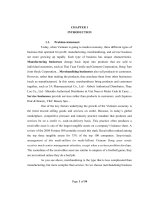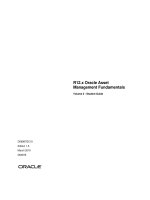Forum Asset Liability Management
Bạn đang xem bản rút gọn của tài liệu. Xem và tải ngay bản đầy đủ của tài liệu tại đây (2.42 MB, 51 trang )
Forum on Asset Liability Management
Gautam Mitra
Forum on Asset Liability Management
• Background and overview of Asset and Liability Management
• Asset and Liability Management applied to Banks
• Asset and Liability Management applied to Insurance
Companies
• Asset and Liability Management applied to Pension Funds
• Asset and Liability Management: Other application areas
• Industry insights, technology, products and services
• Directory of Asset Liability Management Solution and Service
Providers
• Bibliography
Forum on Asset Liability Management
Con Keating
Asset and Liability Management
Some Issues
It is impossible to achieve demonstrably true knowledge about
our universe or ourselves.
Nor is logic decisive. No kind of reasoning can ever give rise
to a new idea.
Hume
London November 2009
Con Keating
5
Liability Driven Investment
The PPF
•
•
•
•
•
•
•
•
•
•
The PPF reported investment returns for 2008/9 of 13.4% including
swaps versus a target of 6.2%
Ex swaps the return was -3.4%
Long dated gilts moved just 3 basis points in this year
But swaps versus gilts (25 year) compressed by 61 basis points
This is a return equivalent of 14.5%
This is the principal source of the swap performance.
Swaps were trading 45 basis points through gilts
Having been 100 basis points through earlier in the crisis
It is a staggering basis risk for the ALM position.
Why does the PPF own swaps which yield less than gilts?
Hedging
•
•
•
•
•
•
•
•
•
A UK corporate borrowed £100 million as a 12 year floating rate
note paying 5/8% over interbank offered two years ago.
They swapped this for fixed paying 5.5%
They entered a credit support agreement for the swap, under which
cash collateral could be called.
Swap rates declined to 4.00%
They were called for collateral of £12.2 million
This was cash they did not have and were forced to borrow from
their bank on adverse terms
The cost of the financing has risen dramatically
The effective term of the financing has shortened
The basis risk is enormous
The individual
•
•
Only 20% of personal wealth takes the form of financial assets and
property.
80% is human capital to be consumed and converted to other
wealth over the future life time.
•
Many other institutions share this property of future income
•
Pension schemes are one example
•
The status quo is simply an accrued endowment - the present
value of future contributions can dominate this entirely.
A pension scheme
•
•
•
•
•
•
•
•
•
•
Once future contributions are considered
The optimisation problem is no longer maximisation of current asset
values at either short or long horizons
The new contributions can be thought of as consuming investments
And for those we want the price of investments to remain low
The ALM problem is dramatically different
Think about a coupon bond when prices decline and yields rise
The realised total return increases due to the higher reinvestment
rates
We no longer want high market (beta) returns since these hurt our
new money contributions
But we do want returns which are independent of the market
And that is the case for Alpha
BrightonRock Policy
•
•
•
•
•
Institutionalises this insight contractually
It stabilises the current value of the portfolio
By removing short term concerns
Allowing long term investment
And lowering scheme financing costs
Forum on Asset Liability Management
Michael Dempster
Forum on Asset Liability Management
Elena Medova
Forum on Asset Liability Management
Moorad Choudhry
Bank Liquidity Risk Management: Reporting and Metrics
Asset Liability Management Forum
MWB, Canary Wharf
17 November 2009
Professor Moorad Choudhry
Europe Arab Bank
Agenda
•
A common approach
• Five liquidity risk metrics
• Reporting considerations
Email:
Please read and note the DISCLAIMER stated at the end of the presentation.
15
Introduction
• Liquidity management has emerged as the dominant
element of bank asset-liability management in the post
2007-08 crisis era
• Measuring and managing liquidity risk is an art rather
than a science and should be undertaken with prudence
and a close eye to the particular bank’s own risk-reward
profile and operating model
16
A common approach…
• Management often direct Treasury and money market desk
behaviour by assigning simple targets (e.g. the Loan-to-Deposit
ratio, or target deposit levels)
• Market best practice is for more than the single liquidity metric
(LTD), to a broader set of measurements and reports (to
complement the LTD).
• For instance, the LTD is the best metric to measure the
contribution of customer funding. The LTD, however, is not
predictive, and is blind to duration, concentration and volatility, three
critical aspects of liquidity. Finally, it is not always “aggregatable”.
• Liquidity forecasts should be upgraded to incorporate better
estimates of deposits/withdrawals on the deposit side, drawings
of unused direct commitments on the loan side, and assessment
of the quality/liquidity of our near-cash assets.
• Post-Lehmans, a bank ALM crisis may arise from a negative gap
situation, a withdrawal of customer deposits or loss of interbank
liquidity, among other scenarios
17
What to Look For from Liquidity Data
Self-sufficiency and supportiveness of a business unit
– Its ability to operate without support of other Group businesses
– Evidence of focus on both sides of the balance sheet
– The level to which it creates or relieves liquidity risk
– Measure of value of the business unit to the Group, in non-P&L
terms
Overall level of exposure to roll risk
– Measuring asset liability mismatch
– Each liability roll is an opportunity to lose funding
Early warning of funding stress points
– Analysing the cash effects of liquidity gaps
– Examining the near term effects of the asset liability mismatch
Specific daily funding needs
– For planning & managing daily operational funding requirements
– For advanced planning of cash or collateral action
18
Metrics: Five Liquidity Reports
•
Loan-to-Deposit Ratio
•
1 Week & 1 Month Liquidity Ratios
•
Cumulative Liquidity Model
•
Inter-company Lending Report
•
Liquidity Risk Factor
These reports measure and illustrate different elements of
liquidity risk:
•
•
•
•
Reports at country level, legal entity level and Group Level
Risk appetite should be determined by the ALCO or (at Group level)
High ALCO
Assumptions will be reviewed by Treasury & Risk Management
Stress testing will be performed by Risk Management
19
Ways to Examine Liquidity Risk
Loan to
Deposit Ratio
1 Week & 1
Month
Liquidity
Ratios
Cumulative
Liquidity
Model
Intercompany
Lending
Report
Liquidity Risk
Factor
Selfsufficiency
of a
business
unit
Supportiven
ess of a
business
unit
Overall level
of exposure
to roll risk
Early
20
Loan-to-Deposit Ratio
Characteristics
• The relationship between lending and customer
deposits
• Measure of the self-sustainability of the bank (or
each branch / subsidiary)
• A very common metric, usually reported monthly
Points to note
• Differentiate between stand-alone and aggregate-able LTD
(depends on transferability and currency)
• Branch / sub targets: to improve the LTD when it’s over a
certain threshold (e.g. 70%), and to maintain their LTD
when it’s under that threshold
• Exceptions can be granted to certain countries in local
currency (LCY) when they are below the threshold and
when the use of their excess liquidity is constrained
21
1-Week & 1-Month Liquidity Ratios
Characteristics
• Shows net cash flows, including the cash effect of liquidating
“liquid” securities, as a percentage of liabilities
• An effective measure of structural liquidity, with early warning of
likely stress points
• Produced weekly, one week in arrears
• Follows a Regulatory Authority limit structure for 1 Week and 1
Month ratios
• It is important to review assumptions including “stickiness”
Country assumptions
1-week Gap 1-week
Liquidity
1-month Liquidity
regularly
USD mm
This week
Limit
Excess
This week Limit
Excess
• Review Limits regularly
F
D
H
G
Regional Total
-1586
188
786
550
-22.83%
15.26%
22.57%
53.27%
-62
-0.48%
-30.00%
0.00%
0.00%
25.00%
-39.11%
1.62%
19.12%
69.83%
-50.00%
-5.00%
-5.00%
25.00%
-10.64%
22
Cumulative Liquidity Model
Characteristics
• Forward looking model of inflows, outflows and available liquidity
• Recognises and predicts liquidity stress points on a cash basis
• Prepared daily, at legal entity level, and Group level
• Prepared for material original currencies and at consolidated
currency level
Note
• Revised assumptions on deposit stickiness, liquidity of “liquid”
securities, and committed facilities will be included here
y
m
m
u
D
ta
a
D
23
Intercompany Lending Report
Characteristics
• This shows the net
intercompany lending
position of each branch / sub
• Measure of the selfsustainability of each
branch / sub
• Clearly displays cash
contributors and cash users
• Major KPI for Treasurers
• Produced monthly
Group Treasury
As at (date)
Total Borrowing
Total Lending
Net Intergroup Lending
London subsidiary
1,713,280
883,123
-830,157
Europe branches
-- X
-- Y
-- Z
3,345,986
17,026
453,490
978,369
195,096
83,420
-2,367,617
178,089
-370,070
0
162,000
162,000
690,949
1,516,251
825,302
Asia
NY
24
Liquidity Risk Factor
Characteristics
• Shows the aggregate size of the liquidity gap in each branch /
sub
• Compares average remaining duration of assets to average
tenor of liabilities
• For example,
– Average asset duration
5.00 years
– Average liability tenor 3 months =
0.25 years
– 5.00/0.25 = Liquidity Risk Factor of 20
• The higher the LRF, the larger the liquidity gap, and the
greater the liquidity risk
• Tenor of liabilities will incorporate revised stickiness
assumptions
• Report weekly and monthly
• Observe the trend over time and change to long-run averages
25









